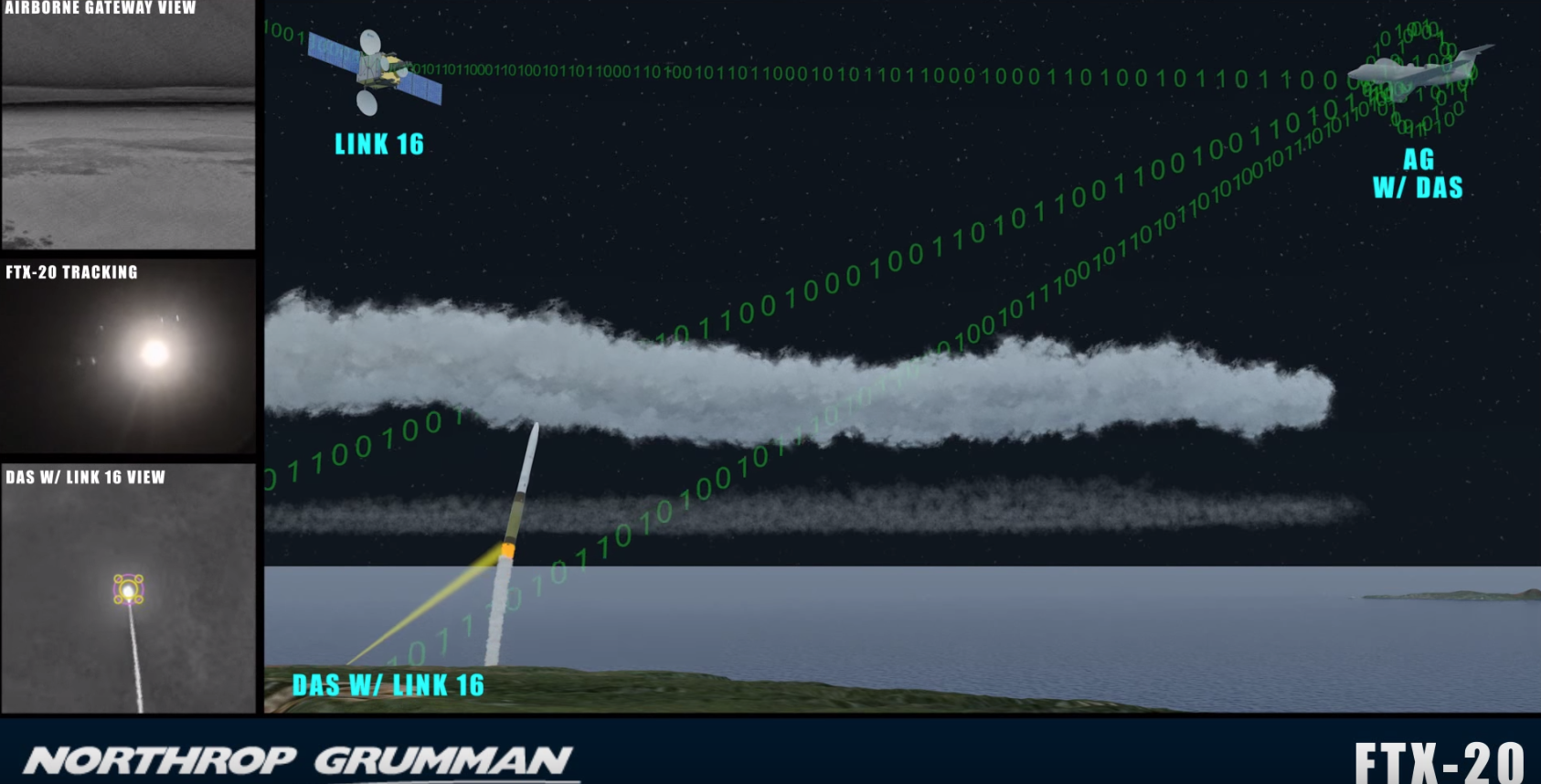In October 2014, Northrop and MDA launched FTX-20, an experiment to see, among other things, whether the DAS could track an enemy ICBM. They took data from the sensors, ran it through algorithms developed by Northrop and MDA’s Enterprise Sensor Lab, generated a 3D-moving picture of the missile’s trajectory, and conveyed it over the Link 16 tactical data exchange. This kind of targeting data can help cue the U.S. Navy’s anti-ballistic missile destroyers or short- and intermediate-range missile defenses like the Army’s Terminal High Altitude Area Defense, or THAAD, missile battery deployed in South Korea.
Northrop Grumman’s Distributed Aperture System can detect and track ballistic missile threats and share the trajectory information across the battlespace via an airborne gateway.
The data would help the other missile-defense gear get a targeting track on a missile more quickly, improving the odds of nailing the shot. (You also need two of them in the air for triangulation.)
Boost Phase Intercept shootdown time needs to be 3 minutes
Boost phase ICBM intercepts require hitting the missile within about 3-5 minutes of launch.
Boost presents different challenges to an intercepting system. Because of the short duration of threat missile boost—no more than five minutes for most missiles, and as short as three minutes for faster-burning solid-propellant threats—the engagement timeline for BPI is short. Further, the missile defense system must be in range of the threat trajectory at the time of launch. Effective targeting requires continual observation of the adversary’s missile systems, and the kill vehicle must be able to withstand the physical stresses associated with engaging a rapidly accelerating missile. Together, these complications constrain boost-phase systems to specific geographic conditions. Smaller adversary countries enable BPI, as interceptors can maintain station closer to potential launch sites within the country. Features such as allied countries or open water for basing interceptors nearby also enhance boost-phase opportunities. A BPI system based on existing or near-term naval capabilities could provide defense against intermediate- and intercontinental-range ballistic missiles under the correct geographic conditions.
Such conditions exist surrounding the Korean peninsula. Improving the U.S. Navy Aegis missile defense capability against intermediate-range ballistic missiles and developing an airborne BPI system could provide the United States with an improved ability to defend assets in theater while simultaneously providing a homeland defense capability against North Korean ICBM threats.
Drones with anti-missiles are needed
An unmanned aerial vehicle (UAV), stationed 350 miles outside North Korean air space at an altitude of 50–55,000 feet and equipped with infra-red sensors and conventional anti-missile ordinance of 225 KG, could bring down even a large ICMB in its boost phase. Once the launch is detected, the UAV’s on-the-ground operators would have nearly a minute to decide to intercept given the speed of North Korea’s missiles — more than enough time to initiate the kill chain.
A boost-phase intercept comes early enough in the missile trajectory that any debris would drop into the Sea of Japan, or over North Korean territory.

The F35 spotting would help with targeting for drones and could spot a launch early enough for Aegis and THAAD to have a chance at hitting it as well. Currently THAAD and Aegis would have no chance of hitting an ICBM in boost phase.
The US the General Atomics Predator C Avenger drone which can carrying up to four suitable interceptor missiles. Conventional aircraft have successfully done BPI tests using missiles of this type. Putting those missiles on a rotating UAV patrol off the North Korean coastline would mean round-the-clock surveillance and detection that provided an extra layer of security from missile attack.





Successfully hitting before launch is even better
The US is approving $4 billion in emergency funds to deal with North Korea, with stepped-up use of cyberweapons to interfere with the North’s control systems before missiles are launched, as well as drones and fighter jets to shoot them down moments after liftoff.
The $4 billion emergency budget sought by the White House is on top of the $8 billion that the Missile Defense Agency has already been granted for this fiscal year, as well as what other military services and agencies are putting into missile defense. Another $440 million was moved from existing programs to anti-missile work two months ago, as the North Korea threat became more serious.

Leonard H. Caveny, a main planner of the rocket-firing drones and a former Navy officer who directed science and technology at the Pentagon’s anti-missile program from 1985 to 1997, said an accelerated program could produce the weapons in a year or less.
Caveny’s team is considering use of the Avenger, a drone made by General Atomics that has a wingspan of 76 feet. “This is going to be a game changer,” said Arthur L. Herman, a senior fellow at the Hudson Institute in Washington, who collaborates with Caveny.
The Pentagon’s Missile Defense Agency is also developing a drone that would fire potent laser beams at rising missiles. But recent plans would have it make its debut no sooner than 2025 — too late to play a role in the current crisis or the Trump presidency.

Brian Wang is a Futurist Thought Leader and a popular Science blogger with 1 million readers per month. His blog Nextbigfuture.com is ranked #1 Science News Blog. It covers many disruptive technology and trends including Space, Robotics, Artificial Intelligence, Medicine, Anti-aging Biotechnology, and Nanotechnology.
Known for identifying cutting edge technologies, he is currently a Co-Founder of a startup and fundraiser for high potential early-stage companies. He is the Head of Research for Allocations for deep technology investments and an Angel Investor at Space Angels.
A frequent speaker at corporations, he has been a TEDx speaker, a Singularity University speaker and guest at numerous interviews for radio and podcasts. He is open to public speaking and advising engagements.

